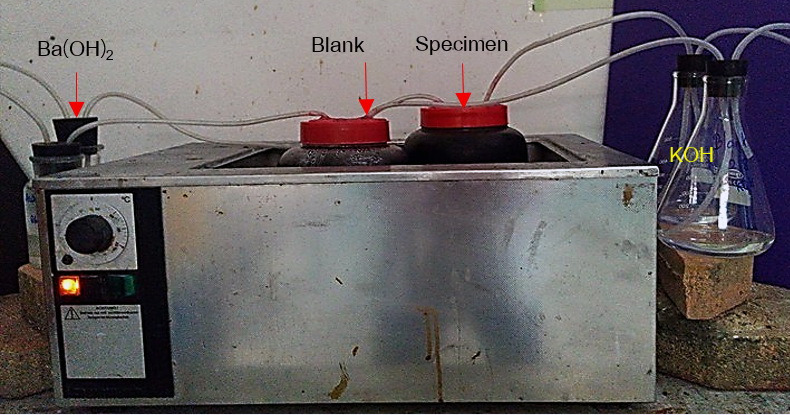การย่อยสลายทางชีวภาพของแผ่นพลาสติกชีวภาพจากแป้งมันสำปะหลังและแป้งสาคู
Main Article Content
Abstract
Duagrathai Kamachaiwet, Chanokchon Sangjan, Polphat Ruamcharoen and Sucheewan Yoyrurob
รับบทความ: 13 มิถุนายน 2564; แก้ไขบทความ: 29 ตุลาคม 2564; ยอมรับตีพิมพ์: 10 พฤศจิกายน 2564; ตีพิมพ์ออนไลน์: 26 เมษายน 2565
บทคัดย่อ
งานวิจัยนี้มุ่งเน้นศึกษาการย่อยสลายทางชีวภาพของแผ่นพลาสติกชีวภาพจากแป้งมันสำปะหลังและแป้งสาคู มีวัตถุประสงค์เพื่อศึกษาระยะเวลาในการย่อยสลายและศึกษาหาปริมาณคาร์บอนไดออกไซด์จากการย่อยสลายทางชีวภาพของแผ่นพลาสติกชีวภาพ ซึ่งได้เตรียมแผ่นพลาสติกชีวภาพในรูปแผ่นฟิล์มโดยใช้เทคนิคสารละลาย ติดตามประสิทธิภาพการย่อยสลายทางชีวภาพกับเวลาและระดับการย่อยสลาย และอัตราการย่อยสลายทางชีวภาพแบบใช้ออกซิเจนในระบบปิดภายใต้สภาพแวดล้อมที่ดัดแปลงจาก ASTM D5538–98 ที่มีการควบคุมด้วยปุ๋ยหมักจุลินทรีย์ จากการศึกษาพบว่าแผ่นพลาสติกชีวภาพจากแป้งมันสำปะหลังมีระยะเวลาในการย่อยสลายสั้นกว่าและมีอัตราการย่อยสลายสูงกว่าแผ่นพลาสติกชีวภาพจากแป้งสาคู เนื่องจากแป้งมันสำปะหลังมีองค์ประกอบที่เป็นอะไมโลสน้อยกว่าแป้งสาคู อะไมโลสซึ่งมีโครงสร้างเป็นโซ่ตรงทำให้เกิดอัตราการสลายตัวที่ช้ากว่าอะไมโลเพ็กตินที่มีโครงสร้างเป็นโซ่ที่มีกิ่งก้านสาขา ผลการวิจัยนี้ยังสามารถทำนายระยะเวลาในการใช้ประโยชน์ของแผ่นพลาสติกชีวภาพได้
คำสำคัญ: การย่อยสลายทางชีวภาพ พลาสติกชีวภาพ แป้งมันสำปะหลัง แป้งสาคู
Abstract
This research focused on biodegradability of bioplastic films made of cassava starch and sago starch. The objectives of this study were to study the degradation period and carbon dioxide from biodegradation of bioplastic films. The films were prepared with the solution casting method. The biodegradation was determined in terms of the degree of degradation and the rate of aerobic biodegradation on exposure to a controlled–composting environment under laboratory condition adapted from ASTM D5538–98. It was found that cassava starch bioplastic films showed less decomposed time and higher rate of degradation than sago starch bioplastic films. This could be corresponded to the less amylose content of cassava starch than sago starch. Amylose is linear structure leading to slower decompose rate than amylopectin which is branch structure. The results of this research can be used to predict the utilization time of bioplastic films.
Keywords: Biodegradability, Bioplastic films, Cassava starch, Sago starch
Downloads
Article Details

This work is licensed under a Creative Commons Attribution-NonCommercial 4.0 International License.
References
Lei Y., Peng H., Wang Y., Liu Y., Han F., Xiao Y., and Gao Y. 2012. Preferential and rapid degradation of raw rice starch by an [alpha]–amylase of glycoside hydrolase subfamily GH13_37. Applied Microbiology and Biotechnology 94:1577–1584.
Locharoenrat, W., Patcharapan, S., and Lertworasirikul, A. (2007). Bio–based polymer Products: Eco–products. In Research Exhibition on Kasetsart Fair 2007. Bangkok: Kasetsart University. (in Thai)
Nigam, S., Das, A. K., and Patidar, M. K. (2021). Synthesis, characterization and biodegradation of bioplastic films produced from Parthenium hysterophorus by incorporating a plasticizer (PEG600). En-vironmental Challenges 5: 100280.
Roasri, S., and Suwan, J. (2015). Preparation and Properties of Bioplastics from Cassava Starch Mixed with Natural Rubber. Rubber and Polymer Technology Program, Faculty of Science and Technology, Songkhla Rajabhat University. (in Thai)
Rosario, L., and Dell, E. (2010). Biodegradability of plastics testing in an undergrad-duate materials laboratory. 2010 Annual Conference & Exposition. Louisville, Kentucky.
.
Shogren, R. L., Lawton, J. W., and Tiefenbacher, K. F. (2002). Baked starch foams: Starch modifications and additives improve process parameters, structure and properties. Industrial Crops and Pro-ducts 1(16): 69–79.
Simachaya, W. (2021). Plastic Waste Surpasses 60% during COVID–19. Retri-eved from http://www.tei.or.th/th/blog_detail. php?blog_id=51, May 22, 2021. (in Thai)
Somyoonsap, P. (2010). Bioplastics: Innovation of green products. Srinakharinwirot Science Journal 26(2): 177–195.
Song, J. H., Murphy, J., Narayan, B., and Davies, G. B. H. (2009). Biodegradable and compostable alternatives to conven-tional plastics. Philosophical Transactions of the Royal Society B 364: 2127–2139.
Sriroth, K., Chollakup, R., Hicks, A., and Oates, C. G. (1999). Structural and Functional Properties of Thai Sago (Metroxylon spp.) Starch Extracted from Different Trunk Portions. USA: Food and Agriculture Organization of the United Nations.
Sun H., Zhao P., Ge X., Xia Y., Hao Z., Liu J., and Peng M. (2010). Recent advances in microbial raw starch degrading enzymes. Applied Biochemistry and Biotechnolology 160: 988–1003.
Swinkels, J. J. M. (1985). Composition and properties of commercial native starches. Starch 37(1): 1–5.
Tharanathan, R. N. (2003). Review biodegradable films and composite coatings past Present and future. Trends in Food Science and Technology 1(14): 71–78.
Varalakshmi, B. (2015). Biodegradation of polythene bag using bacteria isolated from soil. International Journal of Cur-rent Microbiology and Applied Sci-ences 4: 674–680.
